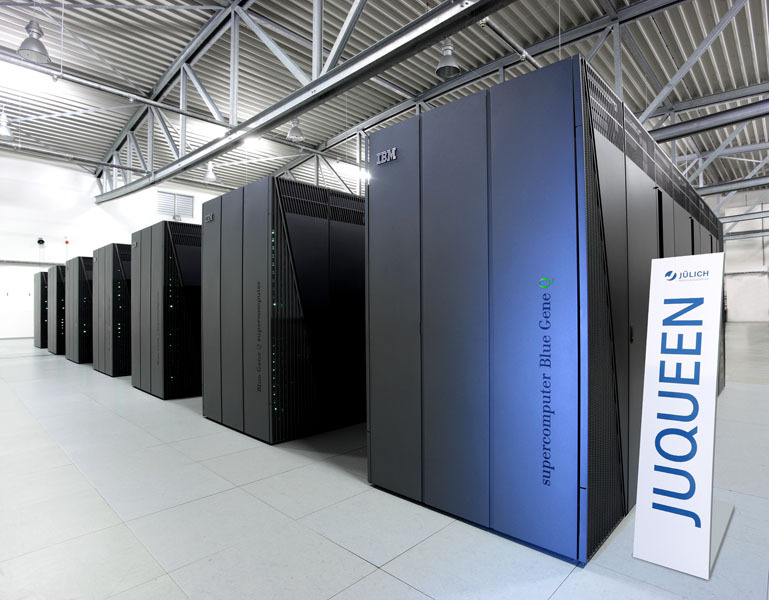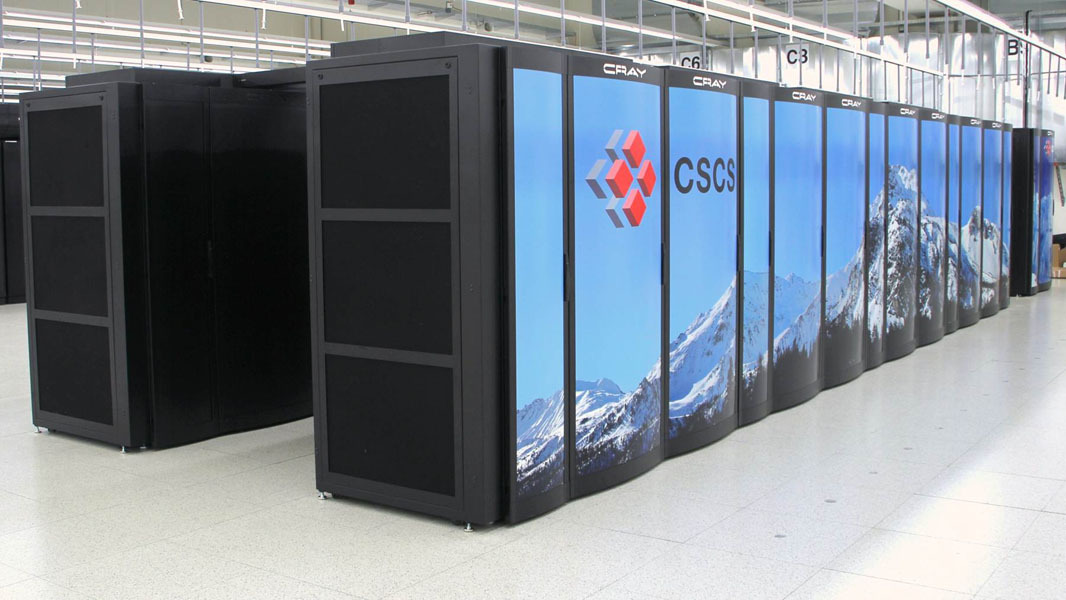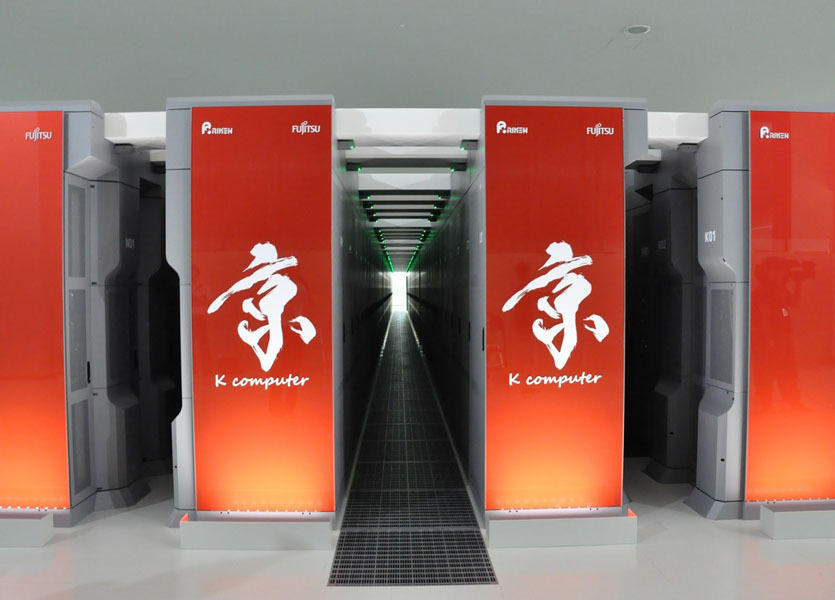The fastest supercomputers in the world
As many computers as there are, so are their super-relatives. Today, the article will talk about the "super-family", or more simply, about the 10 most powerful computers in the world. Who will be the winner?

It is located in the USA. Its exact location and purpose of existence are unknown, since it is not only a supercomputer, but also a super secret object.

Providing 2386.42 megaflops per 1 watt of power, this supercomputer is considered the most energy-efficient. The rated power is 3.57 petaflops. This complex uses Intel Xeon E5-2660v2 10C 2.2GHz processors, and the total number of cores is 72,800.
IBM supercomputer from Livermore National Laboratory, University of California, USA. It began to exist in 2013. Used in various scientific projects of the Livermore's High Performance Computing (HPC) Innovation Center, which in turn is academically collaborating with the Nuclear Safety Administration.

Racks: 24
Cores: 393216
Linpack (Rmax) performance: 4293.31 TFlop / s
Theoretical peak performance: 5033.16 TFlop / s
Power: 1972.00 kW
Memory: 393216 GB
Processor: Power BQC 16C 1.6GHz
Interconnect: Custom Interconnect
OS: Linux
It was developed by IBM specifically for the Julich Research Center, Germany. This supercomputer, based on the Blue Gene / P base, has successfully replaced its predecessor, JUBL, which was created by a more ancient architecture.

At the time of activation, JUQUEEN became the second most powerful supercomputer in the world.
Racks: 28
Cores: 458752
Linpack (Rmax) performance: 5008.86 TFlop / s
Theoretical peak performance: 5872.03 TFlop / s
Power: 2301.00 kW
Memory: 458752 GB
Processor: Power BQC 16C 1.6GHz
Interconnect: Custom Interconnect
OS: Linux
Again from the USA. More specifically, from the Texas Center for Advanced Computing, University of Texas at Austin. Stampede is the brainchild of Dell.

Racks: 182
Cores: 462462
Linpack (Rmax) performance: 5168.11 TFlop / s
Theoretical peak performance: 8520.11 TFlop / s
Power: 4510.00 kW
Memory: 192192 GB
Processor: Xeon E5-2680 8C 2.7GHz
Interconnect: Infiniband FDR
OS: Linux
Compiler: Intel
Math Library: MKL
MPI (Messaging Interface): MVAPICH2
Launched in November 2013 in the Swiss city of Lugano. It is located in the Swiss National Center for Supercomputing (Swiss National Supercomputing Center / CSCS), founded back in 1991. It is used for a large number of various projects, mainly in the field of computer modeling. Piz Daint was created by Cray Inc.

Kernels: 115984
Linpack (Rmax) performance: 6271 TFlop / s
Theoretical peak performance: 7788.85 TFlop / s
Power: 2325.00 kW
Processor: Xeon E5-2670 8C 2.6GHz
Interconnect: Aries interconnect
OS: Cray Linux Environment
Mira is an IBM Blue Gene / Q supercomputer located in the Argonne Leadership Computing building. It is equipped with 786432 cores, 768 terabytes of memory and has a peak performance of 10 petaflops. 49152 compute nodes are equipped with a 1600 MHz PowerPC A2 processor containing 16 cores, 4 hardware threads each. The processor frequency is 1.6 GHz. 16 gigabytes of DDR3 memory. The seventeenth core is used for communication between libraries.

The 5D interconnect configuration from IBM with a 2 Gb / s chip-to-chip connection speed combines nodes, which can significantly increase computing capabilities by reducing the average number of intermediate nodes and delays between computing nodes. The Blue Gene / Q system also has a 4-point floating-point unit (FPU) system that can be used to perform scalar floating-point calculations, 4-dimensional OKMD instructions (single instruction stream, multiple data stream) or 2-dimensional complex arithmetic computing OKMD. These floating point units (FPUs) provide higher computational performance for a single line stream for some applications.
Mira provides access to the 24-GB GPFS file system and throughput of 240 Gb / s. Users will also have access to HPSS data archives and Tukey, a new cluster of analysis and visualization. All of the above resources are available for use over high-speed networks, including ESnet, recently upgraded to 100 Gb / s.
Racks: 48
Cores: 786432
Linpack (Rmax) performance: 8586.61 TFlop / s
Theoretical peak performance: 10066.3 TFlop / s
Power: 3945.00 kW
Memory: 768000 GB
Processor: Power BQC 16C 1.6GHz
Interconnect: 5D Torus Proprietary Network
OS: Linux
Fujitsu supercomputer launched in 2011. Located at the Institute of Physical and Chemical Research, Kobe, Japan.

Racks: 864
Cores: 705024
Linpack (Rmax) performance: 10510 TFlop / s
Theoretical peak performance: 11280.4 TFlop / s
Power: 12659.89 kW
Memory: 1410048 GB
Processor: SPARC64 VIIIfx 8C 2GHz
Interconnect: Custom Interconnect
OS: Linux
A supercomputer created by IBM in June 2012. Used by the National Nuclear Safety Administration for the Advanced Simulation and Computing Program.

Racks: 96
Cores: 1572864
Linpack (Rmax) performance: 17173.2 TFlop / s
Theoretical peak performance: 20132.7 TFlop / s
Power: 7890.00 kW
Memory: 1572864 GB
Processor: Power BQC 16C 1.6GHz
Interconnect: Custom Interconnect
OS: Linux
Supercomputer manufactured by Cray Inc. in October 2012. Titan was an update to the previous Jaguar supercomputer. Located in the Oak Ridge National Laboratory of the University of Tennessee (Oak Ridge, Tennessee, USA). For the most part, Titan’s capacities are used for the US Department of Energy’s Innovative and Novel Computational Impact on Theory and Experiment program (INCITE). This supercomputer was positioned as an apparatus for processing any projects, however, due to the large number of applications, it was decided to limit their number to 6. Among them: fuel combustion processes, material science, nuclear energy and climate change.

Kernels: 560640
Linpack (Rmax) performance: 17590 TFlop / s
Theoretical peak performance: 27112.5 TFlop / s
Power: 8209.00 kW
Memory: 710144 GB
Processor: Opteron 6274 16C 2.2GHz
Interconnect: Cray Gemini interconnect
OS: Cray Linux Environment
There were stereotypes that everything in the Celestial Empire is the cheapest and low-quality, this is not always the case.
The Tianhe-2 supercomputer, designed by Inspur in collaboration with the Defense Science and Technology University of the People's Liberation Army of the People's Republic of China, was launched in 2013. The construction of this giant cost 200-300 million dollars. More than 1300 scientists and engineers worked on the creation of Tianhe-2, which means “Milky Way-2”.
.

Racks: 125
Cores: 3120000
Linpack (Rmax) performance: 33862.7 TFlop / s
Theoretical peak performance: 54902.4 TFlop / s
Power: 17808.00 kW
Memory: 1024000 GB
Interconnect: TH Express-2
OS: Kylin Linux
Compiler: icc
Math library: Intel MKL-11.0.0
MPI (messaging interface): MPICH2 with a customized GLEX Channel

In tenth position is the mysterious Storm CS Cray (Mystery), shrouded in a haze of obscurity.
It is located in the USA. Its exact location and purpose of existence are unknown, since it is not only a supercomputer, but also a super secret object.

Providing 2386.42 megaflops per 1 watt of power, this supercomputer is considered the most energy-efficient. The rated power is 3.57 petaflops. This complex uses Intel Xeon E5-2660v2 10C 2.2GHz processors, and the total number of cores is 72,800.
Ninth on the list is the Vulcan supercomputer
IBM supercomputer from Livermore National Laboratory, University of California, USA. It began to exist in 2013. Used in various scientific projects of the Livermore's High Performance Computing (HPC) Innovation Center, which in turn is academically collaborating with the Nuclear Safety Administration.

Racks: 24
Cores: 393216
Linpack (Rmax) performance: 4293.31 TFlop / s
Theoretical peak performance: 5033.16 TFlop / s
Power: 1972.00 kW
Memory: 393216 GB
Processor: Power BQC 16C 1.6GHz
Interconnect: Custom Interconnect
OS: Linux
Eighth place for several years in a row (since 2012) is occupied by JUQUEEN
It was developed by IBM specifically for the Julich Research Center, Germany. This supercomputer, based on the Blue Gene / P base, has successfully replaced its predecessor, JUBL, which was created by a more ancient architecture.

At the time of activation, JUQUEEN became the second most powerful supercomputer in the world.
Racks: 28
Cores: 458752
Linpack (Rmax) performance: 5008.86 TFlop / s
Theoretical peak performance: 5872.03 TFlop / s
Power: 2301.00 kW
Memory: 458752 GB
Processor: Power BQC 16C 1.6GHz
Interconnect: Custom Interconnect
OS: Linux
Seventh position - Stampede
Again from the USA. More specifically, from the Texas Center for Advanced Computing, University of Texas at Austin. Stampede is the brainchild of Dell.

Racks: 182
Cores: 462462
Linpack (Rmax) performance: 5168.11 TFlop / s
Theoretical peak performance: 8520.11 TFlop / s
Power: 4510.00 kW
Memory: 192192 GB
Processor: Xeon E5-2680 8C 2.7GHz
Interconnect: Infiniband FDR
OS: Linux
Compiler: Intel
Math Library: MKL
MPI (Messaging Interface): MVAPICH2
In sixth place is Piz Daint (Switzerland)
Launched in November 2013 in the Swiss city of Lugano. It is located in the Swiss National Center for Supercomputing (Swiss National Supercomputing Center / CSCS), founded back in 1991. It is used for a large number of various projects, mainly in the field of computer modeling. Piz Daint was created by Cray Inc.
Kernels: 115984
Linpack (Rmax) performance: 6271 TFlop / s
Theoretical peak performance: 7788.85 TFlop / s
Power: 2325.00 kW
Processor: Xeon E5-2670 8C 2.6GHz
Interconnect: Aries interconnect
OS: Cray Linux Environment
At number five we have Mira
Mira is an IBM Blue Gene / Q supercomputer located in the Argonne Leadership Computing building. It is equipped with 786432 cores, 768 terabytes of memory and has a peak performance of 10 petaflops. 49152 compute nodes are equipped with a 1600 MHz PowerPC A2 processor containing 16 cores, 4 hardware threads each. The processor frequency is 1.6 GHz. 16 gigabytes of DDR3 memory. The seventeenth core is used for communication between libraries.

The 5D interconnect configuration from IBM with a 2 Gb / s chip-to-chip connection speed combines nodes, which can significantly increase computing capabilities by reducing the average number of intermediate nodes and delays between computing nodes. The Blue Gene / Q system also has a 4-point floating-point unit (FPU) system that can be used to perform scalar floating-point calculations, 4-dimensional OKMD instructions (single instruction stream, multiple data stream) or 2-dimensional complex arithmetic computing OKMD. These floating point units (FPUs) provide higher computational performance for a single line stream for some applications.
Mira provides access to the 24-GB GPFS file system and throughput of 240 Gb / s. Users will also have access to HPSS data archives and Tukey, a new cluster of analysis and visualization. All of the above resources are available for use over high-speed networks, including ESnet, recently upgraded to 100 Gb / s.
Racks: 48
Cores: 786432
Linpack (Rmax) performance: 8586.61 TFlop / s
Theoretical peak performance: 10066.3 TFlop / s
Power: 3945.00 kW
Memory: 768000 GB
Processor: Power BQC 16C 1.6GHz
Interconnect: 5D Torus Proprietary Network
OS: Linux
Fourth Place K Computer
Fujitsu supercomputer launched in 2011. Located at the Institute of Physical and Chemical Research, Kobe, Japan.

Racks: 864
Cores: 705024
Linpack (Rmax) performance: 10510 TFlop / s
Theoretical peak performance: 11280.4 TFlop / s
Power: 12659.89 kW
Memory: 1410048 GB
Processor: SPARC64 VIIIfx 8C 2GHz
Interconnect: Custom Interconnect
OS: Linux
Closes the top three Sequoia
A supercomputer created by IBM in June 2012. Used by the National Nuclear Safety Administration for the Advanced Simulation and Computing Program.

Racks: 96
Cores: 1572864
Linpack (Rmax) performance: 17173.2 TFlop / s
Theoretical peak performance: 20132.7 TFlop / s
Power: 7890.00 kW
Memory: 1572864 GB
Processor: Power BQC 16C 1.6GHz
Interconnect: Custom Interconnect
OS: Linux
In second place is Titan.
Supercomputer manufactured by Cray Inc. in October 2012. Titan was an update to the previous Jaguar supercomputer. Located in the Oak Ridge National Laboratory of the University of Tennessee (Oak Ridge, Tennessee, USA). For the most part, Titan’s capacities are used for the US Department of Energy’s Innovative and Novel Computational Impact on Theory and Experiment program (INCITE). This supercomputer was positioned as an apparatus for processing any projects, however, due to the large number of applications, it was decided to limit their number to 6. Among them: fuel combustion processes, material science, nuclear energy and climate change.

Kernels: 560640
Linpack (Rmax) performance: 17590 TFlop / s
Theoretical peak performance: 27112.5 TFlop / s
Power: 8209.00 kW
Memory: 710144 GB
Processor: Opteron 6274 16C 2.2GHz
Interconnect: Cray Gemini interconnect
OS: Cray Linux Environment
First place is led by Tianhe-2 (China)
There were stereotypes that everything in the Celestial Empire is the cheapest and low-quality, this is not always the case.
The Tianhe-2 supercomputer, designed by Inspur in collaboration with the Defense Science and Technology University of the People's Liberation Army of the People's Republic of China, was launched in 2013. The construction of this giant cost 200-300 million dollars. More than 1300 scientists and engineers worked on the creation of Tianhe-2, which means “Milky Way-2”.
.

Racks: 125
Cores: 3120000
Linpack (Rmax) performance: 33862.7 TFlop / s
Theoretical peak performance: 54902.4 TFlop / s
Power: 17808.00 kW
Memory: 1024000 GB
Interconnect: TH Express-2
OS: Kylin Linux
Compiler: icc
Math library: Intel MKL-11.0.0
MPI (messaging interface): MPICH2 with a customized GLEX Channel
